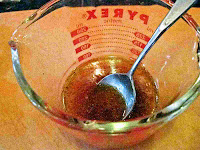1/2 tbsp
1 tbsp potato starch mixed with 1-2 tbsp cold water
This eliminates the smell from having been frozen, and makes shrimp plump in finished dishes.
Mix all seasonings.
5.
Following the instructions on the package, boil noodles and drain.
Ideally, boil them for slightly a shorter time to prevent them from getting too soft later on.
6.
Heat 1 tbsp of canola oil and saute prawns.
7.
In the same frying pan, saute the boiled noodles.
(If the pan it too dry, add more oil before sauteing.)
Raise heat to make the surface crispy.
Do not stir noodles.
Flip when one side is done, and saute the other side.
8.
When both sides are done, put the noodles on a plate.
9.
In the same frying pan, saute vegetables, starting with the firmest (add a small amount of oil if pan is too dry before before putting in vegetables) on medium heat.
Here the firmest vegetable is sliced carrots.
Add other vegetables in order of firmness, and continue sauteing.
10.
When shrimp are warm, add the seasoning mix and stir.
This is the stage to make sure all ingredients are cooked (not to the point of being wilting soft, but crisply done).
Drizzle potato starch & water mixture.
If uncertain how much potato starch to add, drizzle a small amount on the spatula and mix. Stir for several seconds, and add more potato starch mixture if not thick enough.
11.
When ingredients are coated with slightly thickened sauce, pour over the noodles.
Serve immediately.
<Notes>
- Suggested ingredients: vegetables that retain some firmness after cooking, such as gailan Chinese broccoli, chingensai baby bok choy, asparagus, snow peas, and bean sprouts. Among more leafy vegetables, hakusai cabbage adds some sweetness and makes a nice contrast with other crispy vegetables.
- For noodles, Chinese noodles work well too. They tend to need more oil when frying to make them crispy.
- Seasonings for reduced-sodium version
4 tbsp chicken stock
1 tsp soy sauce
1/2 tsp kurozu brown rice vinegar
1/2 tbsp Shaoxing wine
2 tsp XO sauce



















No comments:
Post a Comment